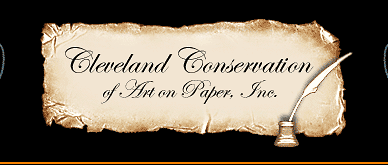





Paper artifacts frequently come in contact with poor-quality adhesives that cause significant and sometimes irreversible damage. One of the most common sources is pressure-sensitive tape, often used to mend tears or secure artworks to backing materials, as with the 18th century American cut silhouette shown here. Unfortunately, the adhesive eventually becomes chemically unstable and leaves unsightly yellow/brown discolorations on the paper. Tape adhesives have many different formulations; as they age, some remain soluble, while others become insoluble and irremovable.
Adhering an entire work of art to a backing material is another common mistake that puts damaging adhesive in contact with the paper. Many glue and paste materials produce acids that cause discoloration and embrittlement. So-called "dry mount" procedures are also undesirable because they introduce adhesives that are often chemically unstable and irreversible.
A number of conservation treatment approaches are available for mitigating tape and adhesive problems. The approach chosen depends on the properties of the adhesive, the paper, and the medium. Treatments typically include some combination of solvents, heat, and/or mechanical manipulation. A suction device may be employed in order to purge the paper of adhesive without disturbing the lay of the fibers. Absorbent materials moistened with solvents (called "poultices") may also be used to draw adhesive residues out of the paper.